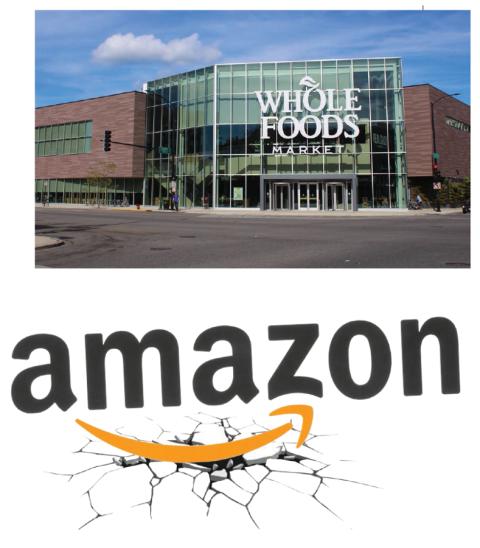Top 50 Grocers: Amazon in 8th Place While Rest of Industry Restrategizes, Reshuffles
(Update: Read the 2019 Top 50 Grocers)
It’s easy to think that the word “disruption” has been overused in descriptions of the transformation that’s taking place in the grocery business. But we’d better get used to it, because things are just getting started.
There it is, at No. 8 in the chart at the end: Amazon.
Read the Rest of Our Analysis
Mind you, for the moment, it’s just as the new owner of record of Whole Foods Market — up from ninth a year ago — and doesn’t reflect other grocery sales, mostly nonperishables, that Amazon has been growing in recent years. But it’s certainly a sign of how things are going to continue to change.
Shortly before the May 2018 issue was completed, it was widely reported that Amazon’s U.S. grocery sales in the first quarter of 2018 rose nearly 50 percent, up to an estimated $650 million, led by coffee, beverages and snacks, according to ecommerce data analyst One Click Retail. Yet while Amazon is the most-shopped online grocer overall, consumers are more often shopping Walmart (the Super 50’s No. 1) online for daily trips, including fresh categories, according to a Coresight Research study.
Download the Complete Rankings
As we observed in our 85th Annual Report of the Grocery Industry in April 2018, Amazon’s rise up the grocery ranks doesn’t sound the death knell for traditional retailers — only for traditional retailing.
To be sure, progressive grocers had been hard at work changing the way they do business prior to the marriage of Amazon and Whole Foods. Grocery technology such as online ordering, click-and-collect, delivery services, scan-and-go platforms, as well as enhanced fresh offerings and compelling in-store experiences are among the many ways that players up and down the Super 50 are making themselves more competitive and relevant to new generations of shoppers.
For some, it has worked. For others, well …

Our analysis a year ago singled out four operators we observed as struggling. Two of them — Indiana's Marsh Supermarkets and Illinois-based wholesaler-retailer Central Grocers — have since filed for bankruptcy, had their assets sold off and have vanished from the Super 50.
The third, New York’s Price Chopper (Golub Corp.) was at the time ranked 24th and seeking an acquisition partner. Since then, the company has continued its transformation into the contemporary Market 32 banner, established grocery technology partnerships with companies like Aptaris and Instacart, and teamed up with Daymon to enhance its sampling programs as part of an elevated shopping experience. The largely employee-owned grocery chain is holding steady in this year’s ranking.
As for the fourth — it was Whole Foods, at the time beset by activist investors looking to change course as the company lost ground to larger players with the scale to deliver now-mainstream natural and organic products at lower prices than “Whole Paycheck” could offer. We all know what happened next — but the story is far from “happily ever after,” as a management and operations culture clash has threatened to undermine Amazon’s fast-paced changes.
Methodology
Information for Progressive Grocer’s annual Super 50 is compiled from direct guidance from retailers and/or data sourced from public records, including 10Ks, annual reports and corporate websites. For privately held companies, results are based on information from Nielsen TDLinx, which collects and maintains store information across all channels selling consumer packaged goods.
The four categories within the Super 50 report include annual sales from the most recently concluded fiscal year, store count, top banners, and employee counts, either total or full-time equivalents. Full-time equivalent employees are the sum of regular workers, plus one-half the number of part-time employees.
Nielsen TDLinx uses Food Marketing Institute’s definition of a supermarket: a grocery store with a minimum of $2 million in annual sales; its data omit sales from convenience, drug and other retail channels that may be part of total revenue for some companies. Wholesale membership clubs such as Sam’s Club, Costco and BJ’s Wholesale Club are also not included. Supercenters are included, but only for their grocery-equivalent merchandise. Not included are soft goods; clothing; general merchandise such as hardware, appliances, computers and auto service; and other items not common to supermarkets.
Sales estimates from Nielsen TDLinx are presented in terms of all-commodity volume (ACV), which is defined as an annualized range of the estimated retail sales volume of all items sold at a retail site that pass through the retailer’s cash registers. Nielsen TDLinx’s ACV is an estimate based on best available data — a directional measure to be used as an indicator of store and account size, not an actual retail sales report. All data are collected by Nielsen TDLinx from a wide range of independent sources, and then enhanced with computer modeling. Information shown is from the March 2018 database.
Fighting Back
In 2017, 21 companies filed for bankruptcy, a new high, noted Andrew Appel, president and CEO of IRI, at the Chicago-based analytics company’s recent annual summit in Las Vegas. Joining the list in 2018 were two regional grocery retailers, upstate New York’s Tops Markets and Southeastern Grocers (SEG), based in Jacksonville, Fla.
And while the wedding of Amazon and Whole Foods certainly “set off a bomb in our industry,” as Appel remarked, it wasn’t the sole or even the leading cause of these grocers’ financial challenges: Tops faced a burdensome debt structure, and SEG was continuing to reinvent itself after filing twice previously for bankruptcy since 2005 as it has struggled in a highly competitive and overstored Southeast.
For its part, SEG has been quite busy during its latest reorganization, thinning its store count with sell-offs to other regional players while remodeling many locations and investing in the expansion of its Hispanic banner Fresco y Más in central Florida, plus rolling out a new loyalty program. SEG’s reorganization plan reduced the grocer’s debt by more than $500 million, and after closing 94 stores, the company will continue to operate 580 stores under the Winn-Dixie, Bi-Lo, Harveys and Fresco y Más banners in seven southern states.
Merger and acquisition activity is expected to continue in the grocery business as companies pursue partners that can not only help them more efficiently serve consumers, but also possess competencies in areas that they seek to enhance to be more competitive (like Kroger did in acquiring Harris Teeter, for its click-and-collect prowess, and Roundy’s, to get fresh-savant Mariano’s).
“We predict that legacy consumer and retail companies will fight back in 2018 and seek out adjacent and convergent businesses,” says Bahige El-Rayes, principal at A.T. Kearney and co-author of the Chicago-based global management consulting firm’s “2018 Consumer and Retail M&A Report.” “Winners will be those that understand what consumers prefer and the channels they use, take a holistic view of their industry, and fearlessly pursue innovative, out-of-the-box opportunities.”
One change to next year’s ranking we already know: Houston-based Fiesta Mart (44th) was acquired earlier this year by Bodega Latina Corp. (48th), the California-based subsidiary of Mexican company Grupo Comercial Chedraui S.A.B. DE C.V. As PG reported in March, the deal will create one of the largest Hispanic-focused supermarket companies in the United States, with 122 stores in California, Arizona, Nevada, New Mexico and Texas, a region where more than half of the fast-growing U.S. Hispanic population lives.
Our drill-down into the Super 50 continues will continue throughout the week. Check back daily for the latest update.
| 2018 Rank | 2017 Rank | Company | Fiscal Year-End Sales (000) |
| 1 | 1 | Walmart Inc. | $159,809,000 |
| 2 | 2 | The Kroger Co. | $79,240,200 |
| 3 | 3 | Albertsons Cos. Inc. | $61,261,200 |
| 4 | 4 | Ahold Delhaize USA | $46,119,320 |
| 5 | 5 | Publix Super Markets Inc. | $28,535,000 |
| 6 | 6 | H.E. Butt Grocery Co. | $16,451,500 |
| 7 | 8 | Wakefern Food Corp. (*Aggregate of ShopRite, Price Rite and The Fresh Grocer banners) | $16,300,000 |
| 8 | 9 | Amazon (as Whole Foods Market) | $15,655,900 |
| 9 | 10 | Aldi Inc. | $14,664,780 |
| 10 | 12 | Trader Joe's Co. | $13,000,000 |




